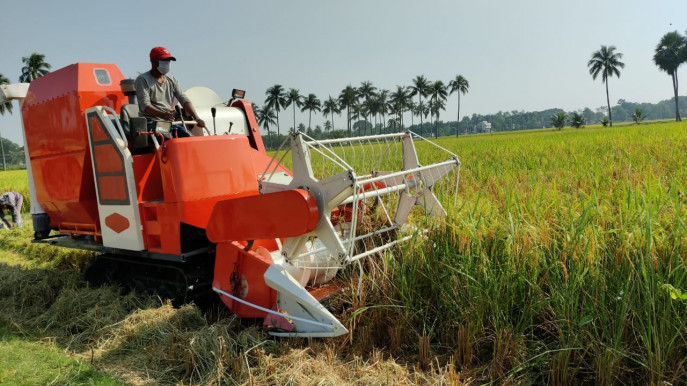Key Takeaways:
- Investing in a modern combine harvester can significantly boost farm productivity.
- Technological advancements in combined harvesters offer enhanced efficiency and precision.
- Considering the combined harvester price and the potential return on investment is essential.
- Improved maintenance techniques can extend the lifespan of modern machinery.
- Modern combine harvesters contribute to sustainable and profitable farming practices.
Introduction to Modern Combine Harvesters
In the rapidly evolving field of agriculture, staying ahead with the latest technology is not just an advantage but a necessity. A modern combine harvester is a critical piece of equipment in today’s farming toolkit, designed to combine three operations—reaping, threshing, and winnowing—into a single process. This machinery saves time and significantly increases farm productivity by streamlining the harvesting operation. Additionally, modern combine harvesters are built to handle a variety of crops, making them versatile and valuable investments for farmers. When considering the factors that affect combine harvester price, it’s essential to weigh the cost against this advanced technology’s potential benefits and long-term savings. These factors include the harvester’s brand, model, age, technological features, and market demand and supply dynamics.
Technological Advancements in Combine Harvesters
The modern combine harvester has seen numerous technological advancements that enhance its efficiency and precision. Innovations such as GPS-guided steering, advanced sensors, and automated control systems have transformed how farmers manage their harvests. GPS-guided steering ensures the harvester operates along precise rows, maximizing coverage and minimizing overlap, thereby increasing field efficiency. Advanced sensors can monitor crop conditions in real-time, providing invaluable data that helps optimize harvesting. These sensors can detect moisture levels, grain quality, and even the presence of weeds, allowing the harvester to adjust its settings automatically for optimum performance. Automated control systems adjust the harvester’s speed, header height, and threshing settings on the fly, ensuring optimal performance regardless of varying field conditions.
Moreover, some modern combine harvesters are equipped with telematics systems that allow farmers to monitor and control the machinery remotely. These systems offer live updates on the harvester’s whereabouts, productivity, and fuel use, allowing farmers to make informed choices to improve productivity. Digital tools like these are at the forefront of the agricultural revolution, making farming more innovative and efficient.
Return on Investment
Investing in a modern combine harvester often requires a significant financial commitment. Nevertheless, the ROI can be significant when considering the overall enhancements in productivity and cost savings. Modern combine harvesters are designed to enhance productivity by covering more ground in less time and reducing the need for manual labor. This efficiency can result in higher yields and quicker harvest times, allowing farmers to plant subsequent crops sooner and maximize land use.
Moreover, the high precision of these machines results in less crop loss during harvesting, translating to higher yields and greater profitability. Features such as automated grain handling systems ensure that more of the harvested crop makes it to market in good condition. When calculating the potential ROI, consider not just the initial cost but the long-term savings and increased revenue potential that a modern combined harvester can offer. For instance, the reduced need for labor and lower fuel consumption can result in significant operational cost savings over the machine’s life.
Maintenance and Longevity
Regular maintenance ensures a modern combine harvester’s longevity and optimal performance. These machines are complex and feature numerous moving parts that require regular attention to function effectively. Implementing a rigorous maintenance schedule, including routine inspections, timely repairs, and proper storage, can extend the life of the machinery. Routine inspections can help identify potential issues before they become major problems, preventing costly breakdowns during critical harvesting periods.
High-quality, manufacturer-recommended parts and lubricants are essential for maintaining the harvester’s performance. Proper lubrication of moving parts can reduce wear and tear, extending the machinery’s lifespan. correct proper storage in a sheltered, dry place can also protect the harvester from the elements and reduce the risk of rust and other damage.
Interestingly, proper machinery maintenance protects the investment and saves money in the long run. According to an article, machinery maintenance can save you money by minimizing the need for significant repairs and reducing downtime. Furthermore, keeping the harvester in good condition can enhance its resale value, providing an additional financial benefit when upgrading.
Sustainability Benefits
Modern combine harvesters are designed with sustainability, offering several benefits that contribute to more environmentally friendly farming practices. Their advanced technology allows for more efficient fuel use, reducing the overall carbon footprint of farming operations. Many modern harvesters have engines that meet strict emissions standards, minimizing their environmental impact.
Additionally, precision agriculture techniques enabled by modern machinery help minimize waste by more accurately targeting inputs such as fertilizers and pesticides. This targeted approach reduces the chemicals used, lowering the potential for runoff and soil contamination. Sustainable farming techniques such as these benefit the environment and contribute to long-term cost savings for farmers. By investing in a modern combine harvester, farmers can cultivate their land more responsibly while maintaining high productivity levels.
Moreover, the increased efficiency of modern combine harvesters can lead to fewer passes over the field, reducing soil compaction and preserving soil health. Healthier soil contributes to better crop yields and more sustainable land use. These sustainable practices align with the growing consumer demand for environmentally friendly and responsibly produced goods, potentially opening new markets and increasing profitability for farmers.
Conclusion
In conclusion, investing in a modern combine harvester is a forward-thinking decision that can significantly boost the efficiency and profitability of a farming operation. The technological advancements in modern harvesters offer precise, efficient, and sustainable farming solutions that are vital for meeting the growing global food demand. By considering the cost, potential ROI, and long-term benefits of improved maintenance and sustainability, farmers can make an informed decision that secures their productivity for years. Embracing modern agricultural technology is not just an investment in machinery but in the future of farming itself.







